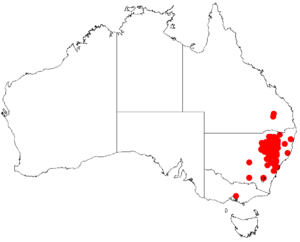Motherumbah facts for kids
Quick facts for kids Motherumbah |
|
|---|---|
| Scientific classification | |
| Genus: |
Acacia
|
| Species: |
cheelii
|
 |
|
| Occurrence data from AVH | |
Acacia cheelii, commonly known as motherumbah or motherumbung, is a tree. It belongs to the Acacia family and grows naturally in eastern Australia.
What Motherumbah Looks Like
This tree usually grows up to 10 m (33 ft) tall. It has a slender trunk that looks whitish-grey. The bark is reddish-brown to brownish and can be flaky or ribbon-like.
The young branches are reddish-brown or brown. They are smooth and become flatter towards their tips. These branches often have a white, powdery coating.
Like most Acacia trees, Motherumbah has special leaf-like parts called phyllodes instead of true leaves. These phyllodes are grey-green and stay on the tree all year. They are usually long and narrow, shaped like a very thin oval. They can be straight or slightly curved.
These phyllodes are about 6 to 23 cm (2.4 to 9.1 in) long and 6 to 32 mm (0.24 to 1.26 in) wide. They have three to six main veins that are easy to see. The tree blooms with golden flowers between August and late October.
Naming the Tree
The scientific name Acacia cheelii honors a person named Edwin Cheel. He used to work at the National Herbarium of New South Wales. The second part of the name, "cheelii," is called the specific epithet. It's like a last name for the plant, helping us tell it apart from other Acacia species.
Where Motherumbah Grows
This tree is found only in certain parts of New South Wales, Australia. It grows on the north-western slopes of the Great Dividing Range and the north-western plains. You can also find it in the Hunter Valley region.
Motherumbah usually grows on stony or rocky hilltops and hillsides. It prefers thin or sandy soils. It is often found as part of Eucalyptus woodlands or scrublands. You can see it from around Murrurundi in the south to the Warrumbungle Mountain and Pilliga Scrub in the west. It also grows near Torrington and Warialda in the north.

